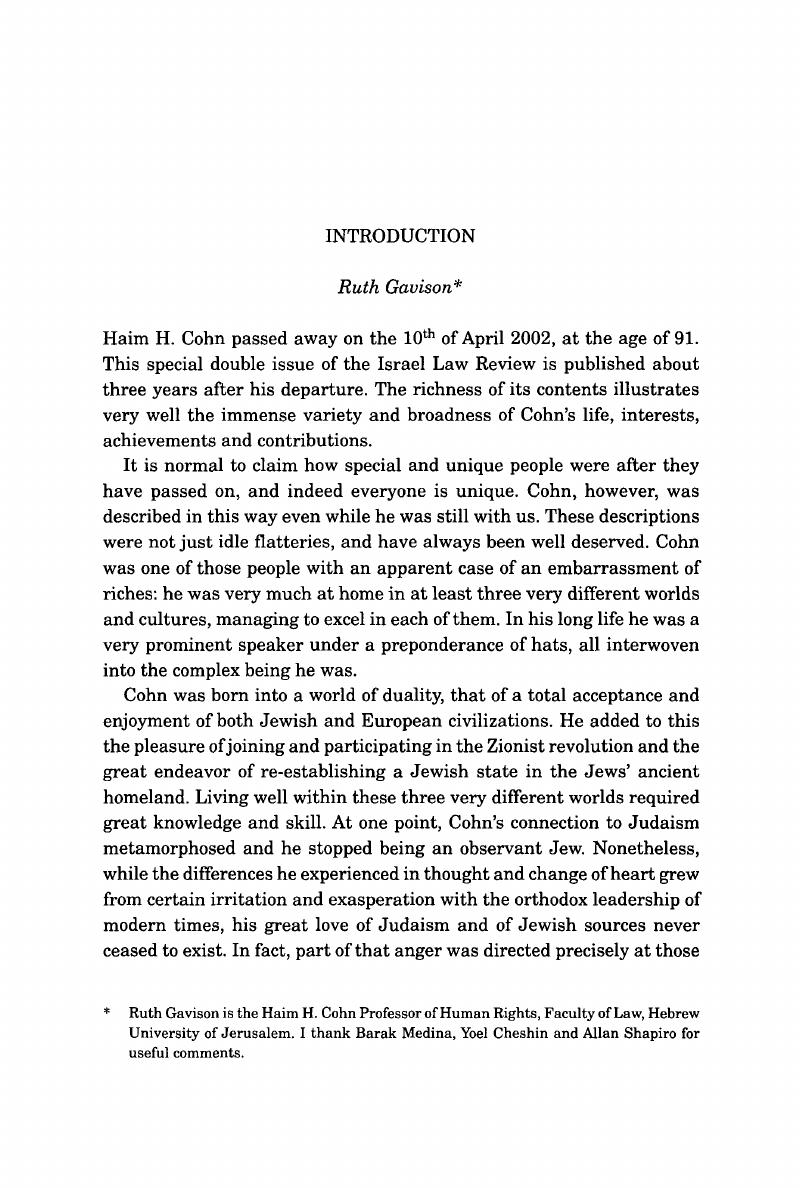No CrossRef data available.
Article contents
Abstract

- Type
- Introduction
- Information
- Israel Law Review , Volume 37 , Issue 2-3: Special Issue in Memory of Haim H. Cohn , Summer–Fall 2004 , pp. 229 - 237
- Copyright
- Copyright © Cambridge University Press and The Faculty of Law, The Hebrew University of Jerusalem 2004
Footnotes
Ruth Gavison is the Haim H. Cohn Professor of Human Rights, Faculty of Law, Hebrew University of Jerusalem. I thank Barak Medina, Yoel Cheshin and Allan Shapiro for useful comments.
References
1 Cohn, Haim H., “Din Emet La-amito” in Gavison, Ruth and Kermnitzer, Mordechai, ed. Essays in Honor of Shimon Agranat (Jerusalem, Machon Sacher, 1986) 35 Google Scholar [in Hebrew].
2 In fact, the issue concerned Cohn personally, since he was the one who decided to prosecute Grunwald, leading to the famous Kastner trial in which Justice Agranat started expressing thoughts about these issues. Cohn used to say this was the most significant decision he had made, but never expressed public doubts on its justification.
3 See Cohn, Haim H., “The Religious Dimension in Marriage Ceremonies: Studies in the History of Comparative Law” in Barak, Aharon, Englard, Izhak, Rabello, Alfredo, Shalev, Gabriela, eds. Essays in Memory of Professor Guido Tadeski (Jerusalem, Harry Sacher Institute for Legislative Research and Comparative Law, 1995) 265–307 Google Scholar. [in Hebrew].
4 Cohn brings this case as an example of a rare case in which disobedience to a law may be justified because the law can be seen as running against the spirit of the law and the wish of a just legislature: Cohn, Haim H., “Parshanut Ne'emana – Talta Mashma” (1976) 7 Mishpatim 5 Google Scholar [in Hebrew].
5 I.A. 1/65 Yeredor v. Chairman of the Central Election Committee 19 (3) P.D. 365.
6 H.C.J. 320/80 Kawasma v. The Minister of Defense 35 (3) P.D. 113.
7 Cohn, Haim H., “Deportation According to Law” (1993) 1 Mishpat Umimshal 471 Google Scholar [in Hebrew].
8 Cohn, Haim H., “Dancing Before a (Coalition) Bride” (1995) 3 Mishpat Umimshal 321–336 Google Scholar [in Hebrew].
9 See Cohn, Haim H., “On the Justiciability Debate” (2001) 1 Kiryat Hamishpat 5–16 Google Scholar. [in Hebrew]; Cohn, Haim H., “Some Heretical Thoughts about the Public Trust” Sefer Shamgar Vol. 2 (Tel Aviv, The Israel Bar Publishing House, 2003) 365 Google Scholar [in Hebrew].
10 See, E.g., Cohn, Haim H., “Aharon Barak: Interpretation in Law” (1993) 1 Mishpat Umimshal 545 Google Scholar [in Hebrew/; Cohn, Haim H., “Banquo's Ghost: Hagel's Theory of Punishment” (1987–1988) 22 Is.L.R. 132 CrossRefGoogle Scholar.
11 See Cohn, Haim H., “The Values of A Jewish and Democratic State – The Basic-Law: Human Dignity and Liberty” (1994) Hapraklit 9 Google Scholar [in Hebrew]; Cohn, Haim H., “The Jewihness of the State of Israel” (1998) 16 Alpayim 9 Google Scholar [in Hebrew].
12 See e.g. Cohn, Haim H., “The Immorality of Punishment” (1991) 25 Is. L.R. 28 Google Scholar. Here, too, we can see how Cohn ties his modern interests with Jewish sources. He seemed to enjoy writing about ancient forms of punishment in Jewish law, for example stoning and hanging.
13 Shoham, Shlomo ed., Of Law and Man – Essays in Honor of Haim Cohn (New York, Sabra, 1971)Google Scholar; Gavison, Ruth, ed. Human Rights in Israel – Essays in Honor of Haim H. Cohn (Jerusalem, ACRI, 1982)Google Scholar [in Hebrew]; Gafni, Isaiah and Motzkin, Gabriel, eds. Priesthood and Monarchy, Studies in the Historical Relationships of Religion and State (Jerusalem, Zalman Shazar Center for Jewish History, 1987)Google Scholar [in Hebrew]; (1979–1980) 6–7 Shnaton Hamishpat Haivri – Annual of the Institute for Research in Jewish Law [in Hebrew]; The following tome was published after Cohn's Death: Shavah, Menasheh ed. “Volume in Memory of Haim H. Cohn” (2003) 3 Kiryat Hamishpat [in Hebrew]Google Scholar.




